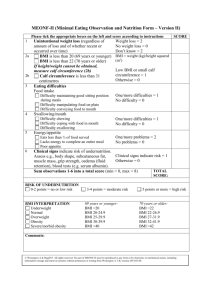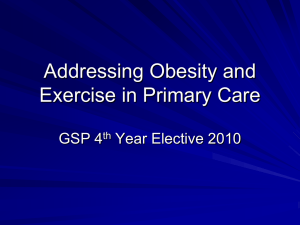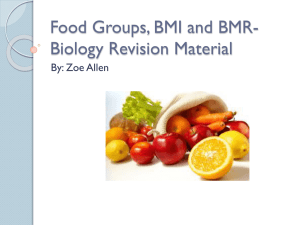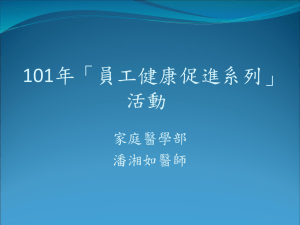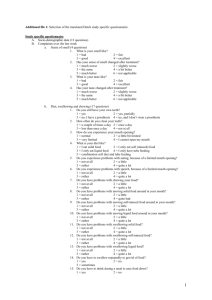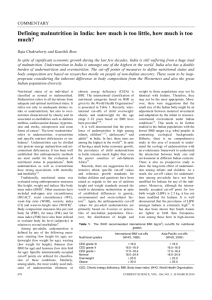MEONF-II (Minimal Eating Observation and
advertisement
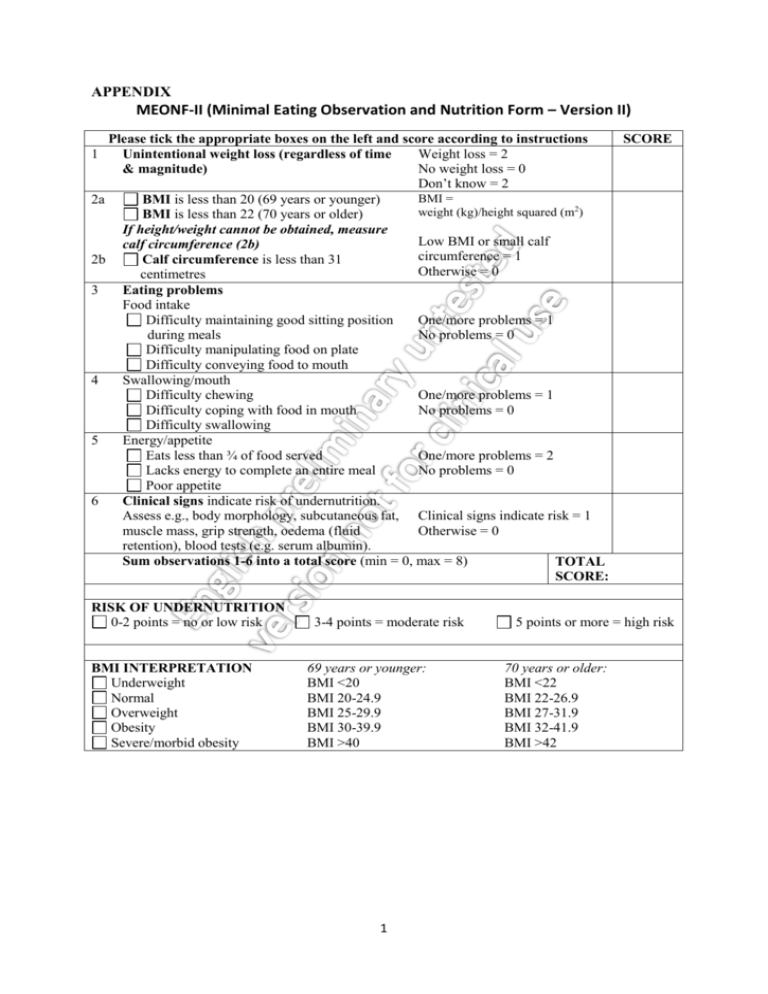
APPENDIX MEONF-II (Minimal Eating Observation and Nutrition Form – Version II) Please tick the appropriate boxes on the left and score according to instructions Weight loss = 2 Unintentional weight loss (regardless of time No weight loss = 0 & magnitude) Don’t know = 2 BMI = 2a BMI is less than 20 (69 years or younger) weight (kg)/height squared (m2) BMI is less than 22 (70 years or older) If height/weight cannot be obtained, measure Low BMI or small calf calf circumference (2b) circumference = 1 2b Calf circumference is less than 31 Otherwise = 0 centimetres 3 Eating problems Food intake Difficulty maintaining good sitting position One/more problems = 1 during meals No problems = 0 Difficulty manipulating food on plate Difficulty conveying food to mouth 4 Swallowing/mouth Difficulty chewing One/more problems = 1 Difficulty coping with food in mouth No problems = 0 Difficulty swallowing 5 Energy/appetite Eats less than ¾ of food served One/more problems = 2 Lacks energy to complete an entire meal No problems = 0 Poor appetite 6 Clinical signs indicate risk of undernutrition. Assess e.g., body morphology, subcutaneous fat, Clinical signs indicate risk = 1 muscle mass, grip strength, oedema (fluid Otherwise = 0 retention), blood tests (e.g. serum albumin). Sum observations 1-6 into a total score (min = 0, max = 8) TOTAL SCORE: SCORE 1 RISK OF UNDERNUTRITION 0-2 points = no or low risk BMI INTERPRETATION Underweight Normal Overweight Obesity Severe/morbid obesity 3-4 points = moderate risk 69 years or younger: BMI <20 BMI 20-24.9 BMI 25-29.9 BMI 30-39.9 BMI >40 1 5 points or more = high risk 70 years or older: BMI <22 BMI 22-26.9 BMI 27-31.9 BMI 32-41.9 BMI >42 The MEONF-II Manual Assessment of nutritional status: The patient/resident should be weighed and measured, preferably first thing in the morning, before breakfast. The patient/resident should only be wearing underwear. If this is not possible, information about height and weight can be obtained from the patient chart or by asking the person. Information about weight should be no more than one month old. 1. Unintentional weight loss (regardless of time & magnitude). Ask the patient and also review documentation relating to weight history. Ask whether rings, watch, or clothes are beginning to fit loosely. Also ask whether the person is intentionally trying to lose weight. 2a. BMI is calculated according to the following formula: weight (kg)/height squared (m 2). If height and/or weight cannot be obtained to calculate BMI – measure calf circumference instead. 2b. Calf circumference is measured in centimeters. Measure the calf at the widest point. Also measure above and below the widest point, to ensure that the first measurement was the largest. Eating problems (items 3-5 below): The patient/resident should preferably be assessed by observing the individual during a meal. If this is not possible the assessment may be carried out by interviewing the patient/resident. If a person has assistive devices/assistance to be able to eat, note that the person has special needs (under “Comments”). For example, if the person has a soft diet due to swallowing difficulties, state that swallowing difficulties are present, even if they are not evident since the consistency of the diet was modified. 3. Food intake Maintaining good Sits independently and with unrestricted mobility sitting position during meals Manipulating food on Uses both hands, only spills occasionally, does not have plate with inner lip or special plate cutlery, uses traditional flatware (not a spoon for meat and potatoes), cuts food and butters bread, puts down glass unassisted Conveying food to Coordinates arms/trunk/head when food is conveyed to mouth, does not need a bib, mouth finds mouth without problems, only spills occasionally, no adapted equipment such as mug or straw 4. Swallowing/mouth Chewing Both “up and down” and rotating/grinding chewing movements. No modification of food consistency. Able to bite off pieces of food, does not rip them off. Food does not fall from mouth while chewing. Coping with food in Food is moved to back of mouth without problems. No food remains in mouth after mouth meals. Able to talk between bites. Swallowing No coughing during meals that may be attributed to aspiration. Smooth swallowing movement when food is completely chewed. No delay or concentrated effort before swallowing. Mouth essentially empty after swallowing. 5. Energy/appetite Eats less than ¾ of It is assumed that portion size is adapted to individual needs (quantity and content). food served Patient does not have feeding tube/IV due to inadequate food intake. Lacks energy to Meal is interrupted due to lack of energy to continue (not due to satiety). complete an entire meal Poor appetite If possible, ask directly; if not, make an assessment. Appetite should be compared with the person’s usual appetite. 6. Clinical signs. Indicate risk of undernutrition. Assess e.g. body morphology, subcutaneous fat, muscle mass, grip strength, oedema (fluid retention), biochemical markers (e.g. serum albumin) Total score. Note that unintentional weight loss gives 2 points, as do problems related to Energy/appetite, as it is known that they are strongly associated with undernutrition. Interpretation of MEONF-II total scores 0-2 points = No or Low risk of undernutrition 3-4 points = Moderate risk of undernutrition 5 points or more = High risk of undernutrition When the initial assessment is carried out, proceed by planning interventions! High BMI (overweight/obesity) is not part of the assessment of risk for undernutrition. Please note, however, that overweight/obesity may occur in the presence of undernutrition that requires intervention. 2
